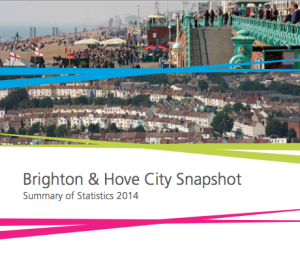A new report gives a series of insights into Brighton and Hove through statistics and a plain English commentary.
They are contained in a 30-page Brighton and Hove City Snapshot: Summary of Statistics 2014 and the fuller 137-page Brighton and Hove City Snapshot: Report of Statistics 2014.
Some of the detail was reported on Friday (18 July) by the Brighton and Hove Independent free weekly newspaper which published a two-page infographic.
 It described a growing population, squeezed into every spare acre, and a diverse population, with one in five citizens from a black or minority ethnic background.
It described a growing population, squeezed into every spare acre, and a diverse population, with one in five citizens from a black or minority ethnic background.
It described relatively small households, with fewer children and older people than elsewhere but more than 30,000 students contributing hundreds of millions of pounds and thousands of jobs to the local economy.
It found substantial prosperity and high levels of satisfaction with everyday life but pockets of significant deprivation, with nearly one in five children living in poverty.
There are currently ten major developments under construction in the city, the report said, with the number of planning applications rising slightly. It added that in 2012-13 there was a net decrease of business floor space of 8,364 square metres and a net decrease of retail floor space of 1,766 square metres. But restaurant floor space increased by 2,812 square metres.
The report was compiled by the Corporate Policy and Research Team at Brighton and Hove City Council. The report and summary were published by the council and Brighton and Hove Connected, formerly known as the Local Strategic Partnership.
Key statistics relate to population, neighbourhoods, ethnicity, sexuality, older people, children and young people, health and wellbeing, transport and infrastructure, culture and leisure, business and enterprise, employment and skills, housing and the environment.
The findings include
- Brighton and Hove has the highest number of people in same-sex civil partnerships. It is five times higher than the proportion found in the south east and England as a whole
- For one in 12 residents aged over three (21,833 people or 8.3 per cent) English is not their main or preferred language, with Arabic the most widely spoken language in the city after English, used by 0.8 per cent of residents or 2,226 people
- A lower proportion of older people – over 65 – live in Brighton and Hove than the regional or national average.
- Brighton and Hove is in line with averages for over 90s
- The number of older people fell 12 per cent from 40,450 in the 2001 census to 35,692 in the 2011 census
- About 12 per cent or 14,468 houses or flats out of a total of 121,540 are occupied by people aged 65 years or more who live alone
- At the time of the most recent Child Poverty Index (2011), 19.6 per cent of dependent children were living in poverty
- A relatively high proportion of our pupils have special educational needs – last year 20 per cent of pupils (7,213) had special needs without statements, compared with 16 per cent in England and 16.3 per cent in the south east
All the statistics are included in the Brighton and Hove City Snapshot: Summary of Statistics 2014 and the Brighton and Hove City Snapshot: Report of Statistics 2014.
For the summary and the full report, visit: www.bhconnected.org.uk/content/reports.








